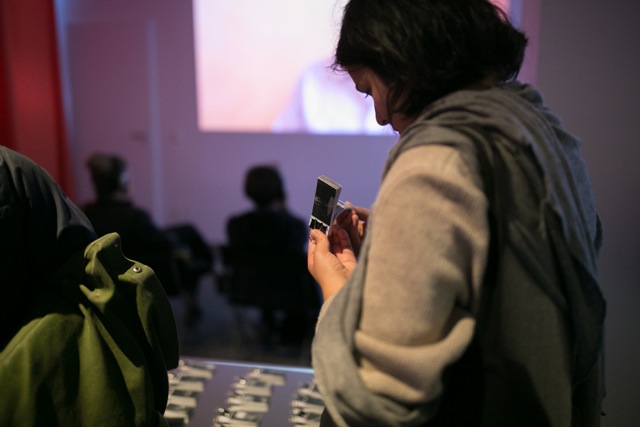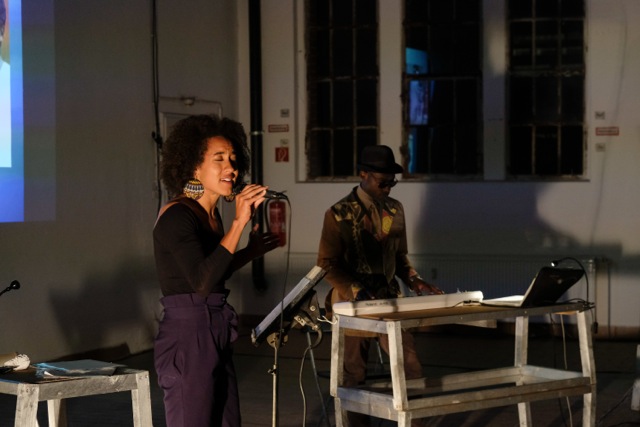Revolt She Said: Decolonial and Feminist Perspectives on 1968 at District Berlin
Revolt She Said: Decolonial and Feminist Perspectives on 1968, District Berlin and Alpha Nova & Galerie Futura, September 2018 – January 2019.
In European and especially German history, 1968 marks the beginning of far-reaching critical engagement on the part of students and established intellectuals with the rise and fall of fascism, and its continuities in postwar societies. The ensuing protests—carried out by students, sometimes in cooperation with trade unions, notably in France—aimed to shake up not only politics and state institutions, but also social mores and gender roles. On a global scale, 1968 stands for the blossoming of liberation movements at the fault lines of the Cold War’s conflicting imperialist claims.
From the perspective of art history, the 1960s mark the beginning of the “epoch” of contemporary art. This decade saw an upsurge of “open” and intermedial works of art that challenged existing boundaries between artistic disciplines, and between art and everyday life. At this time, the field of aesthetics shifted its focus from the properties of the artwork to the experience of art, concomitant with a boom of live and performance art in which the work’s importance and meaning resided in the viewer’s interpretation and participation. Just as importantly, non-white, female and queer artists and activists started to make themselves heard, within the broader culture and in art.
Revolt She Said, a series of talks, lecture-performances and concerts organized by District Berlin and Alpha Nova & Galerie Futura, in Berlin, reviewed the artistic and cultural histories of 1968 through the lens of decolonial and feminist perspectives. In so doing, it offered a broader view of 1968, one that looked beyond the student revolts and known figureheads of the period to consider the contributions of often overlooked figures, and their continued legacies for the present time. Inspired by a 1960s avant-garde sensibility still relevant today, these lines of inquiry included the reconstructed film, the filmic interview, called-out names or the performed metaphorical monument, giving precedence to the fragment, the first-person narrative, the multiplicity of perspectives and the live event.

Karina Griffith. We Call It Love: An Oppositional Screening. Installation view, District Berlin 2018. Photo: Kim Bode.
The Canadian artist and curator Karina Griffith moderated the opening panel titled Uncracking the Archive. In parallel and on view at District, was a one-room installation developed by Griffith that thematized a forgotten graduation film by the Ghanaian filmmaker King Ampaw, a student at Munich’s Hochschule für Film und Fernsehen from 1967 to 1972 who studied alongside Wim Wenders and Werner Herzog. As part of the installation, Griffith presented the film as a collection of flipbooks, a reaction to the fact that permission could not be obtained from the Bundesarchiv, where the film is held, to screen it at District. The installation thus appropriated the distribution of Ampaw’s forgotten work, allowing each visitor to participate in the act of “screening” the film.
In the panel discussion, Griffith, artist Nathalie Anguezomo Mba Bikoro, and academic Natasha A. Kelly discussed strategies to work around some of the difficulties they have encountered while working with archives, including Western and male narratives that underlie the ordering of archival materials and unpermissive rules that govern the consultation and use of the materials. Bikoro appealed to archives to open up and embrace the tasks of “transforming and transmitting”: “The archive is also about involving the community and has to be reinvented all the time.” For Kelly, staying true to herself while navigating the “code” of the archive means identifying as both an academic and an activist.

Corina Shika Kwami and Kelvin Sholar.Talking Blues. Lecture-Performance, District Berlin, September 22, 2018. Photo by Kim Bode.
Kelly, together with vocalist Corina S. Kwami and pianist Kelvin Sholar, led the lecture-performance titled Talking Blues. Inspired by Angela Davis’s writings on the connections between female blues singers of the 1920s and 1930s and black feminism, Kelly traced the links between the music of Fasia Jansen (Germany), Miriam Makeba (South Africa), and Nina Simone (USA), and liberation movements active in the 1960s and 70s. Kelly’s lecture introduced a canon of iconic Black singers into the history of 1968; their songs punctuated the joint lecture by Kwami and Sholar, and connected with Kelly’s words, to bring the struggles and sentiments addressed within the presentation into the present moment.
Alternative historical methodologies as the prerequisite for revealing alternative historical narratives was the topic of the workshop Sexual Self-determination and Anti-Colonial (Liberation) Movements, led by academic and activist Peggy Piesche. Citing Audre Lorde’s dictum “The master’s tools will never dismantle the master’s house,” Piesche argued that decolonizing 68 requires breaking out of the Western temporal matrix underlying normative 1968 historiography to consider other temporalities. From the perspective of many African states, for example, 1968 was not a beginning, but rather the end of a decade of liberation. For Piesche, expanding the methodological toolkit means questioning one’s own assumptions about who qualifies as a valid witness, and moving beyond the categories of heroes and heroines. Piesche showed excerpts of film interviews she conducted with agents of history who do not possess the typical biographies of the heroes and heroines often identified with the events of 1968, such as Berlin-based women activists hailing from the Turkish-Kurdish, African-diasporic, and Roma communities. Piesche also screened as a short documentary on singer and activist Fasia Jansen, who was also featured in Kelly’s lecture-performances.
The film program Revolt She Felt, also curated by Griffith, included Kathleen and Eldridge Cleaver in Algiers (1970) by Claudia von Alemann, founder with Helke Sander of the first International Womens’ Film Seminar in West Berlin in 1973. In an accompanying discussion with the director, Alemann reported that she had brought just two rolls of 16mm film to Algiers to shoot statements by the Cleavers—US civil rights activists who were in exile there at the time of filming—as part of a civic West German campaign calling for Black Panthers founder Bobby Seale to be freed from imprisonment. Griffith introduced emotion as an analytical lens, suggesting that “irritation” rather than “anger” might better bring into focus the urgency with which the Cleavers address the camera. Emotion seemed an apt analytical frame for the film, which Alemann said she made with the aim to inform and agitate; it also struck a chord with the young audience at the screening, who expressed sympathy with the activists’ rousing speeches.
The speakers of the panel Feminist Artistic Positions in the Mirror of their Materialities, moderated by artist and academic Lisa Glauer, discussed artistic materials used by women artists since the 1960s and 70s. Artist and panelist Liz Bachhuber suggested thinking about artistic materials in terms of their use and recognizing the fact that specific materials are more frequently used in feminist art practices, as a radical contrast to materials used in dominant forms of sculpture associated with male artistic traditions. Curator Gabriele Schor pointed to the often overlooked but significant impact of women artists using ephemeral materials. For example, when materials such as latex disintegrate—as in the work of Austrian artist Renate Bertlmann whose sculptures have had to be recast several times—the work may no longer be exhibited, with obvious consequences for the longevity of the oeuvre.
The panel Experiences, Ruptures, Perspectives: Jewish Feminists on Art and Politics since ’68 gave a platform to Jewish women of different generations and geographical backgrounds, all living and working in Germany. Included were Polish-born composer and pianist Elzbieta Sternlicht, Israeli-born painter Shlomit Lehavi, Berlin-born editor Sharon Adler, and Swiss-born artist Elianna Renner. Although the panelists described having found a fertile environment to develop their work in Germany from the 1970s until today, they all mentioned that given the rise of the political right in recent years, they have entertained leaving the country. Far from giving in to a sense of powerlessness, however, their efforts through their works on memory and to make a mark on the public sphere, signalled a strong sense of commitment and resistance. Adler discussed her project on the biographies of influential but little-known Jewish women that she initiated for the women’s online magazine AVIVA, which she founded in 2000. Renner showed documentation of Call Out (2015-), an ongoing sound art piece in which a growing list of names of influential women is called out at central urban centers, such as Frankfurt and Paris, and the public is encouraged to contribute names to the work. In these participatory projects, the work of memory is shown to be a continuous and collective effort in which everyone is potentially taken to task.

Pınar Öğrenci. “Purple Panic: 43” Performance on Tlatelolco Square. Mexico City, 2015. Photo by Jose Luis Arriaga.
The final event of Revolt She Said was a lecture-performance by the Turkish artist Pınar Öğrenci, in which the built environment appeared variably as witness to authoritarian repression and as the locale of resistance and revolt, connecting the past to the present. At District, the artist spoke in front of a silent video projection of a performance she did in Mexico City in 2015, where she swept up Jacaranda tree blossoms from the sidewalks of the city, and then scattered them on the pavement of Tlatelolco Square, the site of an infamous massacre on October 2nd, 1968. Using fragments of witness accounts, Öğrenci recalled the unfolding of the premeditated and bloody repression of the student and civilian protest at the hands of the military and the police, just days before the opening of the 1968 summer Olympics in Mexico. Öğrenci also recounted what is known of the Iguala kidnapping and alleged killing of forty-three students as they were travelling to a commemoration of Tlatelolco massacre, on the part of government forces in late September 2014. In her video, we see the artist arranging the Jacaranda blossoms into neat piles with a broom, as an ephemeral monument to both occurrences. By combining different layers of live performance, Öğrenci managed to connect this 1968 uprising and its suppression—an event that was at once globally observed and concealed in local media—with more recent events, providing a testimony to unbroken dynamics of oppressions.
Revolt She Said achieved remarkable breadth and depth in engaging with the legacy of 1968. By emphasising the live event and reflecting on methods of history writing, Revolt She Said did not just address, but also performed the aesthetic and intellectual legacies of 1968. A festival of live remembrance, the series celebrated the principle of contemporaneity as it was established in art theory and practice in the 1960s, while showing that remembrance needs to be inclusive and involve multiple perspectives. Owing to the many and multifaceted political and artistic achievements of the 1960s across the world, Revolt She Said made tangible the strategies that have been passed down in the wake of an expanded 1968, and made visible those that are still useful in addressing the many struggles that are ongoing today.




